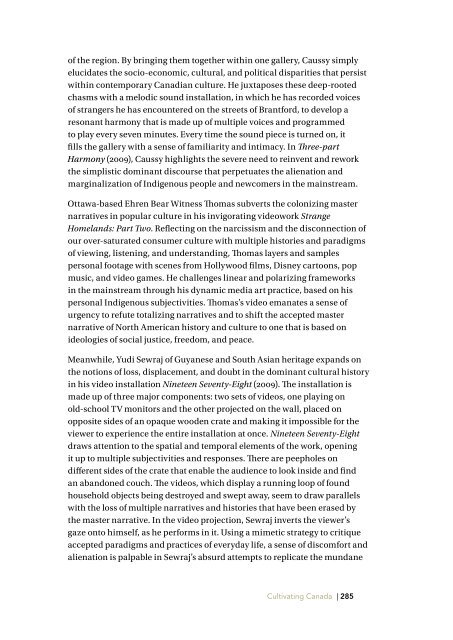Srimoyee Mitra - Speaking My Truth
Srimoyee Mitra - Speaking My Truth
Srimoyee Mitra - Speaking My Truth
- No tags were found...
Create successful ePaper yourself
Turn your PDF publications into a flip-book with our unique Google optimized e-Paper software.
of the region. By bringing them together within one gallery, Caussy simplyelucidates the socio-economic, cultural, and political disparities that persistwithin contemporary Canadian culture. He juxtaposes these deep-rootedchasms with a melodic sound installation, in which he has recorded voicesof strangers he has encountered on the streets of Brantford, to develop aresonant harmony that is made up of multiple voices and programmedto play every seven minutes. Every time the sound piece is turned on, itfills the gallery with a sense of familiarity and intimacy. In Three-partHarmony (2009), Caussy highlights the severe need to reinvent and reworkthe simplistic dominant discourse that perpetuates the alienation andmarginalization of Indigenous people and newcomers in the mainstream.Ottawa-based Ehren Bear Witness Thomas subverts the colonizing masternarratives in popular culture in his invigorating videowork StrangeHomelands: Part Two. Reflecting on the narcissism and the disconnection ofour over-saturated consumer culture with multiple histories and paradigmsof viewing, listening, and understanding, Thomas layers and samplespersonal footage with scenes from Hollywood films, Disney cartoons, popmusic, and video games. He challenges linear and polarizing frameworksin the mainstream through his dynamic media art practice, based on hispersonal Indigenous subjectivities. Thomas’s video emanates a sense ofurgency to refute totalizing narratives and to shift the accepted masternarrative of North American history and culture to one that is based onideologies of social justice, freedom, and peace.Meanwhile, Yudi Sewraj of Guyanese and South Asian heritage expands onthe notions of loss, displacement, and doubt in the dominant cultural historyin his video installation Nineteen Seventy-Eight (2009). The installation ismade up of three major components: two sets of videos, one playing onold-school TV monitors and the other projected on the wall, placed onopposite sides of an opaque wooden crate and making it impossible for theviewer to experience the entire installation at once. Nineteen Seventy-Eightdraws attention to the spatial and temporal elements of the work, openingit up to multiple subjectivities and responses. There are peepholes ondifferent sides of the crate that enable the audience to look inside and findan abandoned couch. The videos, which display a running loop of foundhousehold objects being destroyed and swept away, seem to draw parallelswith the loss of multiple narratives and histories that have been erased bythe master narrative. In the video projection, Sewraj inverts the viewer’sgaze onto himself, as he performs in it. Using a mimetic strategy to critiqueaccepted paradigms and practices of everyday life, a sense of discomfort andalienation is palpable in Sewraj’s absurd attempts to replicate the mundaneCultivating Canada | 285
















